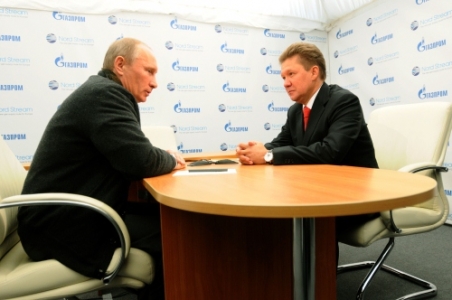
South Stream: A Project with Changeable Geography
Publication: Eurasia Daily Monitor Volume: 9 Issue: 143
By:

Russian President Vladimir Putin wants the South Stream consortium to make a final investment decision by November 2012, and insists that Gazprom start construction work by the same date on the pipeline’s section in the Black Sea (Interfax, July 23; www.kremlin.ru, July 24). With four months remaining until that putative twin deadline, however, the European geography of this pipeline system remains undetermined and subject to constant modifications.
First announced in 2007 and fleshed out in 2009, South Stream’s European geography has been reconfigured many times, ruling some countries in, ruling other countries out, or changing the supply and transit offers to various countries, at Putin’s and Gazprom’s discretion. This process continues at present. It is made possible by the project’s overall structure as devised by Gazprom, involving separate agreements with each target country, preventing any coordination between them, and playing off some countries against others.
Gazprom divides the overall South Stream project into separate country sections. The pipeline section in each country is conceived as a joint venture of Gazprom and the national gas company. Each joint venture is supposed to finance, build, and operate South Stream’s pipeline section in each country. Gazprom, however, retains control of design, construction and (de facto) of operation on each country section, and retains commercial control of the overall project as its sole supplier with gas. Pipeline construction costs are supposed to be shared by Gazprom with each participant country (roughly on a fifty-fifty basis, with certain host countries having to borrow from Russia in order to cover their share). Thus, participant countries would themselves subsidize their own long-term overdependence on Gazprom.
All this would eventuate if the South Stream system is ever built, which continues to look unlikely (see below) despite Moscow’s promotional campaign. Gazprom, interchangeably with Putin’s Kremlin, negotiates with each target country separately about participation in the project and the supply and transit volumes, with considerable scope for manipulation.
This model is a far cry from the consortium model adopted by EU-backed multinational projects, such as Nabucco. In that model, shareholders can take common decisions in the common interest, while the project company is responsible to the consortium’s shareholders. In South Stream, by contrast, there is no consortium for the overland pipeline system. Instead, the South Stream project is a sum total of purely bilateral agreements between Gazprom and each country, with Gazprom in the driver’s seat, overall and locally. The consortium model is only being used for the pipeline’s offshore section in the Black Sea, where Gazprom needs the support of Western companies (see EDM July 26).
The primary supply pipeline is planned to cross the Black Sea from Russia to Bulgaria. There, it will divide into a route to Greece and southern Italy, and another route to Serbia, Hungary and Austria, terminating at the Baumgarten continental gas hub near Vienna. Branch-off pipelines are being offered to countries situated along these routes. However, Gazprom and the Kremlin continually raise doubts over their plans, offering multiple variations and options (South Stream map, apparently from 2010, at https://gazprom.com/f/posts/85/290063/southern-corridor-en.jpg [sic]).
In 2010-2011, Moscow proposed to re-direct South Stream from Bulgaria to Romania (and onward to Central Europe). The Kremlin was retaliating against the Bulgarian government’s attempts to exit from the project or at least mitigate its terms. Some Romanian decision-makers leaped at Moscow’s offer, which increased Russian leverage on Bulgaria. At that time, Romania’s firmly Western-oriented President Traian Basescu ensured that Romania stayed out of South Stream. But Basescu is currently suspended from office, under threat to be removed altogether by new government leaders with uncertain foreign-policy intentions. Meanwhile, Moscow wants Bulgaria to finalize the South Stream project agreement before November 2012, when Bulgaria’s gas supply contract and price are up for re-negotiation with Gazprom. Ahead of that deadline, Moscow will probably test out Romania’s new government, again offering to include Romania in South Stream, as a means of raising pressure on Bulgaria.
On December 30, 2011, then-Prime Minister Putin and Gazprom CEO Alexei Miller made public a revised plan that dropped the Greece-southern Italy route altogether, retaining the Bulgaria-Serbia-Hungary-Austria route. They announced that amputation exactly when South Stream’s prospects seemed to improve, as Turkey allowed the pipeline’s Black Sea section to reach Bulgaria through Turkey’s exclusive economic zone (see EDM, January 9).
Dropping the Greece-southern Italy route had been in the offing since 2010, however, as Italian ENI avoided involvement in that route and saw its stake reduced from 50 percent to 20 percent in South Stream’s Black Sea section. Moscow probably also calculated that an insolvent Greece could not finance its share of the South Stream project. More recently, however, Gazprom joined the international tender to acquire Greece’s gas transmission system, DEPA (three obscure Russian companies are also bidding). To stimulate the Greek government, Gazprom suggests that it might include Greece in South Stream after all, depending on the DEPA tender’s outcome (Interfax, June 15).
At present, Moscow proposes one major route from Bulgaria to Serbia, Hungary, Slovenia (transit solution), and via Slovenia to northern Italy. From that main line, branch-offs are proposed to reach into Macedonia, the Bosnian Serb entity (Republika Srpska), and Austria. On paper at least, Bulgaria loses a major transit opportunity with Gazprom’s scrapping of the Bulgaria-Greece-Italy line. But the entire South Stream debate has a virtual character. Already in 2011, the Bulgarian and Hungarian governments elevated the Nabucco project to the status of top national priority. Serbia and the Republika Srpska are the only non-dubitative parties at this stage.
There is also a latent offer from Gazprom to build a branch-off line from Serbia to Croatia. Moscow can reactivate this offer to counter the planned liquefied natural gas (LNG) terminal on Croatia’s Adriatic coast. That LNG project seems equally latent, however.
The current reconfiguration has turned Austria into an ordinary importer country (undoubtedly for lower gas volumes than previously envisaged), without the advantages of a transit country and distribution center for South Stream gas as originally planned. This change followed the European Commission’s decision to invalidate Austrian OMV’s sale to Gazprom of a 50 percent stake in the Baumgarten distribution center. Gazprom lost interest after losing its partial control of that continental hub.
As recently as June 20 (only five months before the putative investment decision and construction start), Gazprom’s vice-president Aleksandr Medvedev reshuffled the cards again. He told the press that Gazprom considers the following trunkline options (overland continuations from the Black Sea offshore line): 1) Bulgaria-Greece- taly; 2) Bulgaria or Romania-Serbia-Hungary-Austria; 3) Bulgaria or Romania-Serbia-Hungary-Slovenia-Italy; 4) Adding branch-offs to Austria and Croatia from the second or third trunklines (Interfax, June 20).
All those serial proposals entail constant changes in the supply volumes and transit terms under negotiation in each case. According to Gazprom and the Kremlin, the South Stream system should ultimately deliver 63 billion cubic meters of gas, and cost upwards of $30 billion (general estimates, not revised from 2009 to date publicly or officially). However, Moscow has never identified the gas supplies (in Russia or elsewhere) since 2009, nor the funding sources.
Variations on South Stream’s geography (as well as its economics) can be discussed indefinitely. They help disguise Russia’s inability to commit the declared amounts of gas and funding to this project. Map games and option-juggling acts seem to have turned this project into a shell game.




